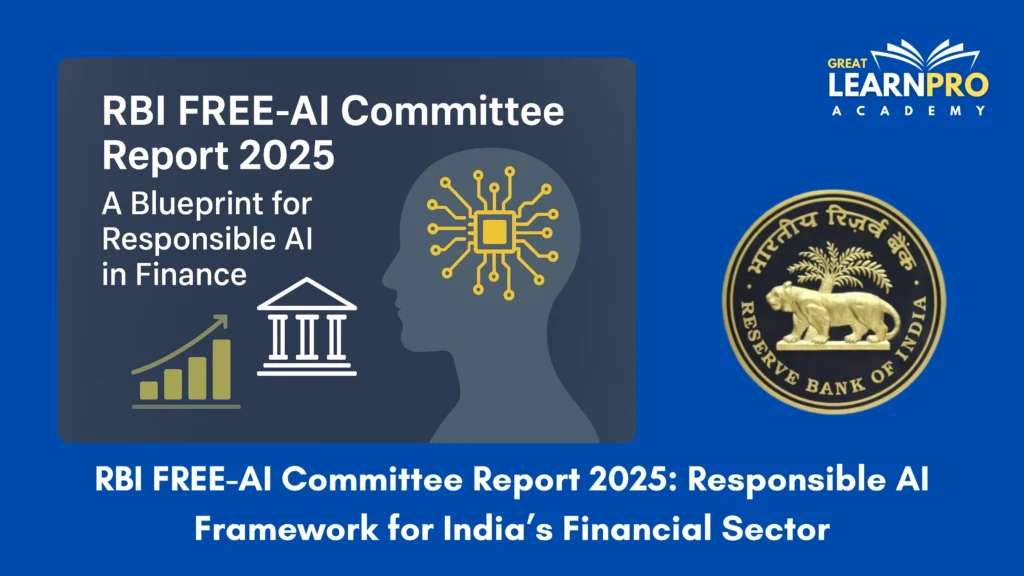
On August 13, 2025, the Reserve Bank of India (RBI) published the report of its Committee on the Framework for Responsible and Ethical Enablement of Artificial Intelligence (FREE-AI) for the financial sector. The committee constituted on December 26, 2024 was tasked with charting an adoption path that unlocks AI’s benefits without compromising consumer protection, prudential soundness, or market integrity.
What the report sets out to do
The report aims to be both a north star and a practical playbook. It pairs seven guiding “Sutras” (principles) with 26 actionable recommendations grouped under six pillars infrastructure, capacity, policy, governance, protection, and assurance. The organizing idea is to “enable innovation in harmony with risk mitigation,” making it clear that the RBI wants India’s financial ecosystem to adopt AI ambitiously but safely.
The seven Sutras (core principles)
The committee articulates seven principles to anchor adoption: Trust is the foundation; People first; Innovation over restraint; Fairness and equity; Accountability; Understandable (explainable) by design; and Safety, resilience and sustainability. These are intended to steer choices around model design, deployment, and oversight across banks, NBFCs and other regulated entities.
Six pillars and 26 recommendations—what’s inside
1) Infrastructure. The committee proposes a high-quality financial-sector data infrastructure conceived as digital public infrastructure to support trustworthy, indigenous AI models. It suggests integrating with national assets like IndiaAI’s AI Kosh and building rails that smaller institutions can also leverage. It also encourages an AI innovation sandbox to test use cases safely before scale-up.
2) Capacity. Boards and C-suites should develop AI literacy and adopt a board-approved AI policy covering governance, risk appetite, operational safeguards and consumer protection. Supervisors too must invest in institutional upskilling to keep rules proportionate to fast-moving technology.
3) Policy. The report recommends adaptive, enabling policies that keep step with AI’s probabilistic nature. It floats the idea of a multi-stakeholder standing committee to continually evaluate AI risks and opportunities, and a dedicated fund to spur home-grown models for Indian finance. It also encourages enabling integration with digital public platforms such as UPI, where appropriate.
4) Governance. Regulated entities should classify AI systems by risk and institute risk-based, calibrated AI audits covering data inputs, models/algorithms, and decision outputs—with continuous monitoring and public reporting where relevant.
5) Protection. Consumer outcomes sit at the center: requirements around fairness, explainability, grievance redress, cybersecurity, and data lifecycle governance are emphasized. Business continuity planning should explicitly include AI-specific failure modes such as performance drift or model degradation.
6) Assurance. The committee leans toward assurance mechanisms from model auditability and documentation to sector-wide oversight to maintain confidence as AI penetrates products and operations. Some coverage in the press also highlights a “tolerant supervisory stance” for first-time AI errors (with adequate safeguards), to avoid chilling innovation an idea that will surely spark debate around customer protection and proportional liability.
Why this matters now
India’s financial sector is already infused with AI from fraud analytics and underwriting to chatbots and collections. What has been missing is a coherent, India-specific framework that marries innovation with prudence and fairness, and that levels the playing field so not only large incumbents but also smaller banks and fintechs can tap reliable infrastructure and sandboxes. The FREE-AI report tries to provide that backbone, while nudging the ecosystem toward explainable, auditable, and human-centered AI.
What to watch next
Implementation will define the framework’s real impact. Key milestones to track include:
- Data infrastructure build-out and its alignment with IndiaAI’s assets.
- The AI innovation sandbox and early cohorts that go through it.
- Sector-specific, indigenous models and whether a dedicated fund catalyzes them.
- How audit frameworks and board-approved AI policies reshape governance inside banks and NBFCs.
- The regulatory conversation around “tolerant supervision”—where to draw the line so learning is encouraged but customers remain protected.
Bottom line: the FREE-AI report is not just a statement of intent; it is a structured to-do list for institutions and supervisors. If executed well, it can accelerate safe, explainable, India-first AI across finance unlocking productivity and inclusion while keeping risks in check.
Sources:
- https://www.reuters.com/sustainability/boards-policy-regulation/india-cenbank-committee-recommends-ai-framework-finance-sector-2025-08-13/?utm_
- https://economictimes.indiatimes.com/news/economy/policy/rbi-panel-submits-report-on-framework-for-ai-use-to-foster-innovation-and-mitigate-risks-in-financial-sector/articleshow/123281944.cms?utm_
- https://timesofindia.indiatimes.com/business/india-business/ai-errors-rbi-panel-calls-for-tolerant-supervision/articleshow/123289599.cms?utm_
More Current Affairs: https://learnproacademy.in/updates/
